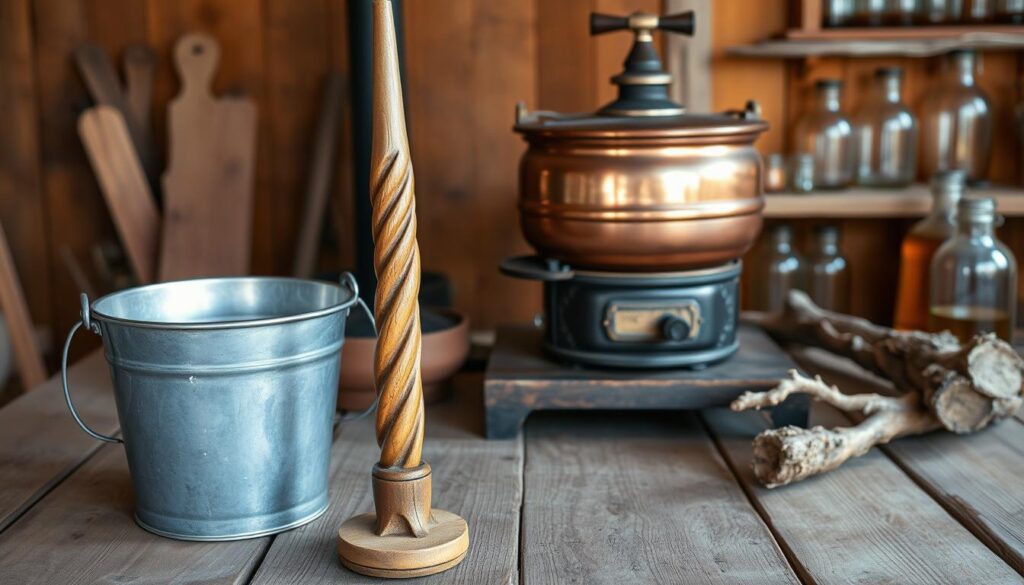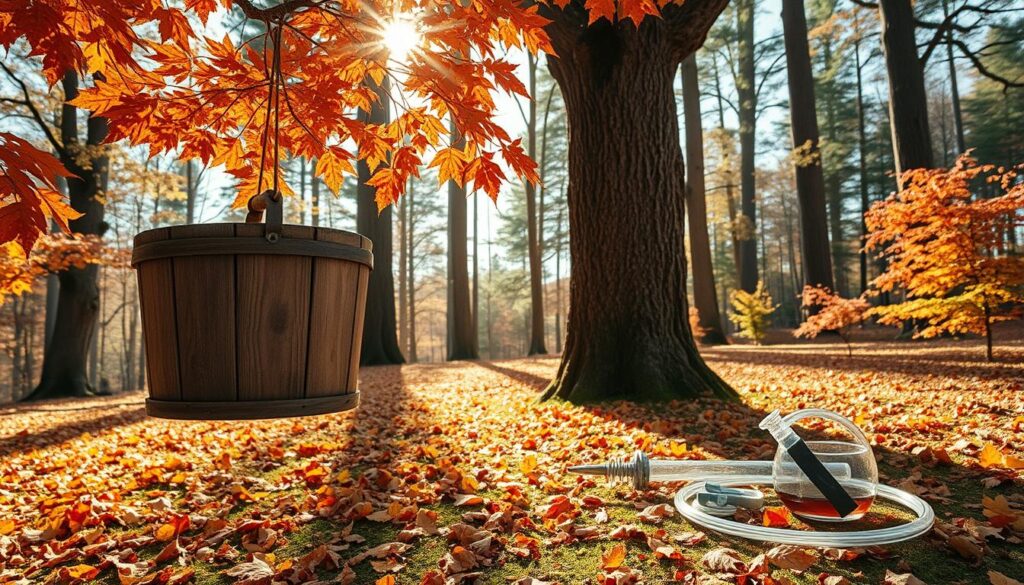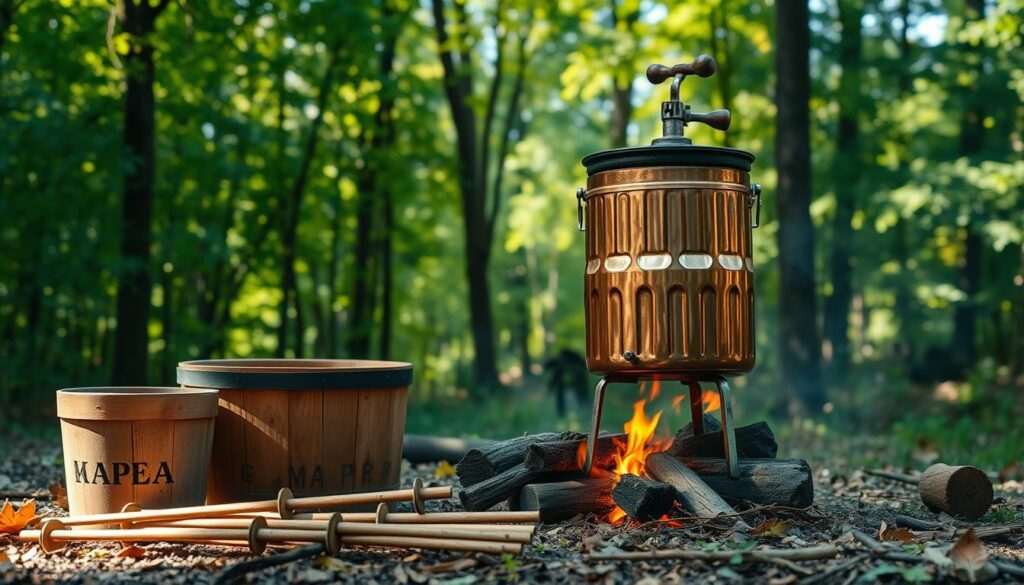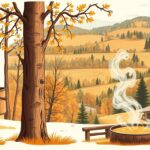Maple syrup making is a tradition in North America. It starts with choosing the right Maple Syrup Harvesting Kit. This kit turns tree tapping into a fun and rewarding activity.
A good Maple Tree Tapping Kit helps both hobbyists and professionals. It lets them get the sweet sap from maple trees. Whether you have a small backyard or a big sugar bush, these kits have what you need.
Collecting maple syrup needs care, patience, and the right tools. Both pros and hobbyists use top-notch gear for the best sap and syrup. Knowing when to tap, which trees to use, and how to do it right is key.
Your Maple Syrup Harvesting Kit is your first step into this world. It helps you learn how to turn sap into delicious syrup. Whether you’re new or experienced, the right tools are essential for great syrup.
This guide will cover everything you need to know for making maple syrup. Get ready for a tasty journey into a long-standing tradition of sustainable food making.
Essential Components of a Complete Maple Syrup Harvesting Kit
Making maple syrup needs special tools that turn tree sap into syrup. The right tools can make a big difference in how easy it is to harvest.
A good maple syrup kit has key parts for collecting sap. Each tool has its own role in making syrup.
Tree Taps and Spiles: The Entry Point
The first step is using tree taps and spiles. These tools are key for getting sap from the tree. They are made from safe materials like stainless steel or plastic.
- Stainless steel spiles for long-term durability
- Plastic taps for lightweight, cost-effective options
- Different sizes to match various tree diameters
Collection Buckets and Bags: Capturing the Liquid
After tapping, you need a way to collect the sap. You can use metal buckets or plastic bags. Each has its own benefits for making syrup.
- Metal buckets: Classic, rust-resistant design
- Plastic bags: Lightweight, easy to transport
- Volume markings for precise measurement
Tubing Systems and Connectors: Advanced Collection
For pros, tubing systems are a big deal. They link taps together for easy sap collection over big areas.
Good tubing design helps keep sap clean and flowing well. It’s a key part of modern sap collection tools.
Getting Started: Choosing the Right Trees for Tapping
Choosing the right maple trees is key to a great Maple Tree Tapping Kit experience. Not all maple trees are good for making syrup.
The best trees for tapping are mature sugar maples, red maples, and black maples. Look for these characteristics when picking trees for your kit:
- Minimum tree diameter of 10 inches
- Healthy bark without significant damage
- Trees at least 40 years old
- Robust root system and full canopy
Experienced sugarmakers say to look for trees that show they’re healthy:
“A thriving maple tree will show consistent growth patterns and vibrant bark texture, signaling its readiness for tapping.”
| Maple Tree Type | Sap Sugar Content | Tapping Suitability |
|---|---|---|
| Sugar Maple | 2.0% | Excellent |
| Red Maple | 1.7% | Good |
| Black Maple | 2.0% | Excellent |
Sustainable tapping practices ensure the long-term health of your maple trees and consistent syrup production. By choosing and caring for your maple trees, you’ll have a steady supply of natural maple syrup.
Understanding Maple Syrup Season and Optimal Harvesting Times
The success of a Maple Syrup Harvesting Kit depends on knowing when to collect sap. Making maple syrup is a precise process tied to weather and location.
Maple syrup needs the right weather to be made. The best time to harvest is when it’s cold at night and warm during the day. This usually happens in late winter and early spring.
Weather Conditions for Sap Flow
For sap collection to work, certain temperatures are key:
- Nighttime temperatures below 32°F (0°C)
- Daytime temperatures above 40°F (4°C)
- Consistent freeze-thaw cycles
Regional Harvesting Calendars
When to harvest maple syrup changes by region:
| Region | Typical Harvest Weeks |
|---|---|
| Northeast United States | Late February – Early April |
| Midwest | March – Mid-April |
| Canada | Late February – Mid-March |
Monitoring Sap Quality
Experienced sugarmakers follow these steps for the best sap:
- Check tree health before tapping
- Use clean, sanitized equipment
- Collect sap quickly to prevent bacterial growth
- Store collected sap at refrigeration temperatures
Learning these detailed techniques will boost your Maple Syrup Harvesting Kit’s success. It ensures top-quality maple syrup.
DIY Maple Syrup Kit Setup for Beginners
Starting your maple syrup journey begins with setting up a DIY Maple Syrup Kit. New sugarmakers need to turn backyard maple trees into syrup. Knowing how to set up is key to entering the maple syrup world.
Before you start with your Maple Syrup Starter Kit, you need the right tools. Here are the essential items for a great maple syrup harvest:
- Reliable tree taps
- Food-grade collection buckets
- Clean storage containers
- Thermometer for sap temperature tracking
- Stainless steel boiling pan
Choosing the right trees is important for making maple syrup. Sugar maple trees are best. Trees with a diameter of at least 10 inches are good for tapping. Young trees should be protected for the forest’s health.
Setting up your DIY Maple Syrup Kit needs care and attention. Clean all your equipment well to keep it sterile. Use the right drilling method for taps and watch the sap flow closely during the season.
Patience and precision are the secret ingredients to creating exceptional maple syrup.
Beginners will face a learning curve. Start small, try different methods, and grow your Maple Syrup Starter Kit as you get better. Making great maple syrup is a mix of science and art.
Professional Sugar Bush Equipment for Large-Scale Production
Maple syrup production grows from a hobby to a business with the right equipment. Sugarmakers use advanced tools to boost efficiency and output.
Big maple syrup operations need special gear for lots of sap and top quality syrup. The right tools are key to big yields.
Commercial Grade Evaporators
Commercial evaporators are the core of maple syrup making. They process huge amounts of sap with great accuracy.
- Stainless steel construction for durability
- Multiple pan configurations
- High-efficiency heat transfer systems
- Automated temperature controls
| Evaporator Type | Capacity | Typical Output |
|---|---|---|
| Small Commercial | 20-50 gallons/hour | 500-1000 gallons/season |
| Large Industrial | 100-200 gallons/hour | 5000-10000 gallons/season |
Storage Tanks and Transport Systems
Keeping sap quality up is key. Professional equipment includes tanks and tubes to keep sap fresh and clean.
- Insulated storage tanks
- Vacuum-assisted collection systems
- Sanitized transport equipment
Filtering Equipment
Good filtering is vital for top syrup quality. Professional tools have advanced filters to remove impurities and make syrup clear.
- Pre-filter stations
- Pressure-based filtration units
- Multiple-stage filtering processes
Buying professional Sugar Bush Equipment is a big step for quality syrup making. Each tool is important for making great syrup from sap.
Maple Sap Collection Methods and Best Practices
Starting with good maple sap collection is key to making syrup. Sugarmakers need to pick the right methods. These methods should get as much sap as possible without harming the trees.
There are a few main ways to collect maple sap:
- Bucket Collection: A classic method using metal or plastic buckets hung directly on tree taps
- Tubing Systems: Modern networks connecting multiple trees for efficient sap extraction
- Gravity-Fed Collection: Utilizing natural downward flow to transport sap
For those who collect sap, timing and technique are very important. The best time to collect sap is when it’s cold at night and warmer during the day.
“The art of maple sap collection is about understanding the tree’s natural rhythm.” – Maple Harvesting Expert
Advanced sap collectors use special tools to make their job easier. These tools help track sap flow, keep the collection clean, and keep the syrup quality high.
| Collection Method | Efficiency | Labor Intensity |
|---|---|---|
| Traditional Bucket | Low | High |
| Tubing System | High | Low |
| Vacuum-Assisted | Very High | Low |
Today’s sap collectors say it’s important to keep equipment clean. They also check their systems often. This helps avoid contamination and keeps the sap quality high.
Evaporator Pan Sets: Types and Selection Guide
Choosing the right Evaporator Pan Set is key for making great maple syrup. These tools turn raw sap into tasty syrup by heating and concentrating it. Knowing the differences in evaporator pan sets can greatly improve your syrup’s quality and how efficiently it’s made.
Maple syrup makers have many choices for Evaporator Pan Sets. The right one depends on several important factors that affect how well it works and what it produces.
Traditional Designs: Craftsmanship and Reliability
Traditional Evaporator Pan Sets usually have:
- Copper for its great heat transfer
- Hand-made metal work with old designs
- Slower but more accurate sap reduction
Material Considerations for Modern Evaporator Pan Sets
Modern Evaporator Pan Sets use new materials to improve performance:
- Stainless steel for lasting durability and easy cleaning
- Aluminum alloys for lightness and efficient heat spread
- Composite materials to make the equipment lighter
Sugarmakers need to think about their specific needs when picking an Evaporator Pan Set. Things like how much syrup you want to make, your budget, and what resources you have are all important.
“The right Evaporator Pan Set turns good maple syrup into an exceptional culinary experience.” – Professional Maple Syrup Producer
Spending time to learn about different Evaporator Pan Sets is worth it. It ensures you get the best results for your maple syrup production.
Safety Protocols and Equipment Maintenance
Keeping safe while making maple syrup is key for both hobbyists and pros. It’s important to handle Maple Syrup Making Supplies with care. This means watching out for risks and keeping equipment in good shape.
Important safety steps for maple syrup gear include:
- Protecting against high-temperature liquids
- Managing fire risks during evaporation
- Maintaining clean and sanitized equipment
- Using appropriate personal protective gear
Working with hot sap and syrup needs careful handling. Experts suggest wearing heat-resistant gloves and long-sleeved clothes to avoid burns. Always be cautious with Maple Syrup Making Supplies during boiling.
| Safety Equipment | Purpose | Recommended Frequency |
|---|---|---|
| Fire Extinguisher | Emergency fire suppression | Keep near evaporation area |
| Thermometer | Monitor sap temperature | Check before each use |
| Protective Eyewear | Prevent splash injuries | Always wear during processing |
Keeping equipment in good shape is vital for safe syrup making. Sugarmakers should clean and check their Maple Syrup Making Supplies regularly. This helps avoid contamination and keeps equipment working well.
“Safety is not an accident, but a deliberate practice in maple syrup production.” – Professional Sugarmaker
By sticking to these safety steps and keeping equipment in top condition, producers can have a safe and successful syrup harvest.
Maple Syrup Production Tools and Their Uses
Maple syrup production needs special tools to turn raw sap into tasty syrup. Sugarmakers use precise instruments and equipment to make sure the syrup is top-notch. This is key for quality and efficiency in the whole process.

Choosing the right tools is very important for sugarmakers. The right equipment makes the whole process easier and more efficient. It turns a tough job into a smooth one.
Measurement Instruments for Precision
Getting the measurements right is key in maple syrup making. Important tools include:
- Sugar Refractometers for sugar content checks
- Digital thermometers for sap and syrup temperature tracking
- Hydrometer sets for density checks
- Graduated containers for tracking volume
Processing Equipment Essentials
Tools for processing go beyond just measuring. They are key in turning raw sap into golden syrup.
| Equipment Type | Primary Function | Importance |
|---|---|---|
| Evaporator | Boils and concentrates sap | Essential for syrup making |
| Filtering System | Removes mineral deposits | Keeps syrup pure and clean |
| Storage Containers | Preserves syrup quality | Keeps flavor and prevents contamination |
Investing in good Maple Syrup Production Tools makes maple sap harvesting a professional job. Each tool is important for making the perfect syrup.
Storage Solutions for Harvesting Equipment
Storing your Maple Syrup Harvesting Kit right is key to keeping your equipment in top shape. It helps make sure you have a great maple syrup season. You need a good plan and to take care of your gear.
Cleaning well is the first step in storing your equipment. After you finish harvesting, clean everything carefully. This stops bacteria and keeps your equipment safe.
- Sanitize all taps, buckets, and collection tools with food-grade sanitizing solutions
- Dry equipment completely before storing to prevent rust and mildew
- Store items in a cool, dry location away from direct sunlight
Each part of your Maple Syrup Harvesting Kit needs special care. Different materials need different ways to stay in good shape.
| Equipment Type | Recommended Storage Method | Temperature Range |
|---|---|---|
| Metal Taps | Hang in cloth bag or plastic container | 50-70°F |
| Plastic Tubing | Coil loosely, store in sealed container | 45-65°F |
| Collection Buckets | Stack with protective padding | 40-75°F |
Professional sugarmakers know that storing equipment right makes it last longer. It also keeps it working well for future seasons.
“A well-maintained tool is a sugarmaker’s best partner in maple syrup production.” – Traditional Maple Syrup Wisdom
Maple Syrup Starter Kit: Building Your Basic Setup
Starting your maple syrup making journey needs careful planning and the right tools. A good Maple Syrup Starter Kit can turn you into a skilled sugarmaker. Knowing the key tools and budget tips will help you succeed in this craft.
Building a detailed Maple Syrup Starter Kit means picking the right tools. These tools should fit your goals and what you can afford.
Essential Tools for Your Kit
- Tree tapping drill and bits
- Stainless steel spiles
- Collection buckets or bags
- Hydrometer for measuring sugar content
- Filtering equipment
- Large stockpot or small evaporator
Budget-Friendly Considerations
Maple syrup making fits all budgets. Beginners can start with little money and grow their Maple Syrup Starter Kit over time.
| Budget Level | Estimated Cost | Recommended Equipment |
|---|---|---|
| Entry-Level | $100-$250 | 5-10 taps, basic collection buckets |
| Intermediate | $250-$500 | 20-50 taps, tubing system, small evaporator |
| Professional | $500-$2000 | Commercial-grade equipment, 50+ taps |
“Start small, learn continuously, and expand your maple syrup making skills gradually.” – Veteran Sugarmaker
Your Maple Syrup Starter Kit is an investment in a traditional craft and tasty homemade syrup. Look for local resources, talk to experienced sugarmakers, and enjoy the maple syrup making journey.
Sustainable Harvesting Practices and Environmental Impact

Producing maple syrup in a sustainable way is more than just collecting sap. It involves careful forest management and knowing the environment. Sugarmakers know that keeping maple forests healthy is key for future syrup makers.
Choosing the right trees and tapping them correctly is vital for forest health. Experts give tips to reduce harm to the environment:
- Tap only mature trees with a diameter of 10 inches or larger
- Limit taps per tree based on trunk size
- Rotate tapping locations to prevent tree damage
- Use clean, sterilized tapping equipment
Keeping the forest ecosystem healthy is key to making maple syrup sustainably. Responsible sugarmakers protect biodiversity by maintaining natural forest habitats. They manage woodland areas carefully, keeping wildlife and plants safe.
Today’s Maple Tree Tapping Kits are made with the environment in mind. They use biodegradable tubing, lightweight systems, and energy-saving methods. These are common among eco-conscious producers.
“Sustainability isn’t just about today’s harvest—it’s about preserving natural resources for tomorrow’s generations.” – Maple Syrup Conservancy
Checking forest health is a big part of sustainable syrup making. It means keeping an eye on tree health, soil quality, and the whole ecosystem. Sustainable harvesting is about working with nature, not against it.
Troubleshooting Common Equipment Issues
Maple syrup production faces many challenges. These can affect how well equipment works and the quality of sap. Knowing about these issues helps sugarmakers keep their equipment in top shape for a good harvest.
Keeping equipment in good condition is key to making maple syrup. Small problems can grow fast. This can hurt your syrup production a lot.
Critical Equipment Maintenance Strategies
- Regular cleaning of taps and collection systems
- Inspecting tubing for damage or leaks
- Checking seals and connections before each season
- Storing equipment properly during off-seasons
Problem-Solving Quick Reference Guide
| Equipment Issue | Potential Cause | Recommended Solution |
|---|---|---|
| Blocked Spiles | Mineral Buildup | Use vinegar solution for deep cleaning |
| Weak Sap Flow | Incorrect Tap Placement | Verify tree health and tap location |
| Leaking Connections | Worn Gaskets | Replace rubber seals annually |
Preventative maintenance is the best way to keep Maple Syrup Making Supplies in great shape. Good equipment care can really boost syrup quality and amount.
Scaling Up: From Hobby to Commercial Production
Going from making maple syrup at home to a big business takes careful planning and a lot of money. Sugarmakers need to think about how much syrup they can make, how much people want to buy, and what equipment they need. This helps them grow their maple syrup business.
Key things to think about when growing your business include:
- Upgrading Sugar Bush Equipment for more syrup
- Buying commercial-grade evaporators
- Expanding sap collection systems
- Knowing the rules and regulations
Professional Sugar Bush Equipment is very important for making maple syrup on a big scale. Big operations need special machines that can handle a lot more sap than small setups. These machines include big evaporators, automated sap collection, and precise filters.
When you want to make more syrup, you need to plan your money carefully. Starting a big syrup business can cost from $10,000 to $100,000, depending on how big you want to be. Good businesses make detailed plans that include how much equipment costs, managing land, and selling syrup.
Important steps for making syrup on a big scale include:
- Do your homework on the market
- Make a solid business plan
- Get the right Sugar Bush Equipment
- Get all the necessary permits and certifications
- Find good ways to sell your syrup
Talking to experienced sugarmakers and going to industry events can give you great tips on how to succeed in making maple syrup for a living.
Conclusion
Creating maple syrup is a rewarding adventure. It combines traditional craftsmanship with modern techniques. A DIY Maple Syrup Kit is key to turning tree sap into liquid gold.
Whether you’re a hobbyist or a commercial producer, knowing the right equipment and techniques is important. It makes your maple syrup production experience better.
Successful maple syrup harvesting starts with careful preparation. You need to choose the right trees and invest in quality tools. The DIY Maple Syrup Kit is more than just equipment. It’s a way to learn the process of making maple syrup.
Those who spend time learning and keeping their equipment in good shape will make high-quality syrup. It’s a journey of learning and improvement.
Start small, try new things, and grow your skills. Maple syrup production is a mix of science, tradition, and culinary art. With patience, passion, and the right tools, you can become a master syrup maker.
Your maple syrup adventure is waiting for you. Embrace the journey, respect the trees, and enjoy the sweet rewards of your hard work.



